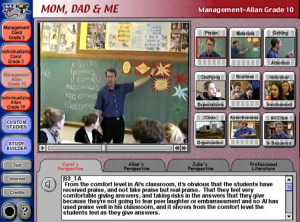Julie Thompson and Dr. R. Carl Harris, Instructional Psychology and Technology
Video Ethnographies bring together video clips, audio clips as well as text to create a case study on a CD-ROM. Our Society is turning towards computer-based education, and this case study fits the mold of one of the desirable ways for students to learn.
The case study I chose to create was based on my parents, who are both teachers. To start this study each of my parents were videotaped teaching a lesson. My mother, Carol taught her grade three class a math lesson and my father, Allan taught his grade ten class a lesson in French. Once these videotapes were completed I reviewed them and decided what questions I wanted my parents to answer. These questions would each become one of the thirty-two probes created. Some examples of questions used are “How do you encourage individual involvement? And “What do you do to make sure both genders are treated fairly in your classroom?” I interviewed Allan and Carol and then gave comments on each of the questions myself. Following the questions I found professional literature that enhanced each of the probes created.
The videotapes were compressed and put onto a CD enabling me to edit the videos as well as the interviews into smaller clips, which would be placed into the video ethnography. A total of 36 video clips were created, and 144 audio clips were used. All of these were placed into a template on a jaz disk, which holds 1GB. The disk needed to be that large because of all the memory that this case study used.
Once all of the video, audio and transcribed text were in place I had to cut pictures from each of the video clips to place on the template. Also each individual button had to be labeled, and the study builder had to be created. The study builder allows the user to create a personalized study by allowing them to insert their own comments and use the video clips of their choice. Copies of the jaz disk were burned onto CDs, which were individually tested for bugs in the program. Since this CD-ROM is made to be cross-platforms (useable on Mac’s and PC’s) I ran into many problems. Some of these included different text fonts on the computers as well as different speeds for the video clips. The benefits of having the study on a CD-ROM is that it is useable on most computers, it is very compact and it allows the viewer to experience the study in a multi-media setting.
I chose my parents to research because I wanted to compare and contrast their teaching styles with each other, as well as with my teaching styles. Each of the video clips has corresponding comments from my mother, father, me, and from professional literature. It has been very interesting to me, as well as others in the education field to see the way we analyzed each of our teaching styles. Both of my parents have had the chance to teach me in their own classrooms as I was growing up. It is because of this that I feel like I have an even deeper perspective on their teaching skills and that helped me with the comments I made.
Here is a copy of the template for my video ethnography. This shows Allan in the third study (management) and the fist probe (praise). The comment shown is Carol’s and pushing the button to the left of it will allow the viewer to hear Carol’s voice giving her comment.

This grant has allowed me to explore technology and research in a way I never knew existed. I feel that the case study I created has not only been a benefit to me, but it will also be useful to other prospective and pre-service teachers. Viewers of this case will gain insight on teaching styles, techniques, useful management tips as well as an in-depth look at the decision to become a teacher and how styles vary even within a family.
This research project would have never been possible without the strong encouragement from my faculty advisor, Carl Harris, computer help from Peter Chan, as well as my parents and their belief in my abilities.
